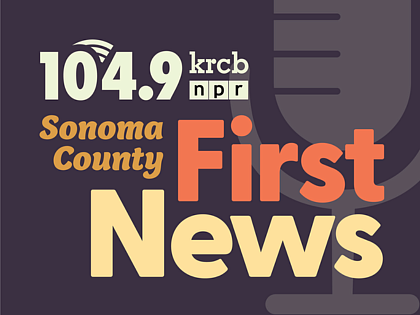 photo credit: Marc Albert/KRCB
photo credit: Marc Albert/KRCBGalleto finishing a talk at SRJC's Multicultural Museum.
Inspiration is all around. Some artists look to landscapes, some the human form. For Sonoma County artist Silver Galleto, it's tradition dating back to before the written word.
"Often when you hear our name, it's always associated with being the best basket-weavers in the world. Not the best basket weavers in California, not the best in the United States, but the best in the entire world. There's very few tribes that do as many techniques, as many styles, designs and as elaborate as they are, so for me, just hearing about our ancestors being known for that, it drew me in, and I wanted to make sure that I could continue that legacy of what we're known for."
A member of the Coast Miwok and Southern Pomo tribe, Galleto lives Windsor, and is active as a tribal leader, a father and in tribal health care.
Before mass production, before machine tools--basketry was a staple of life.
"There's such a wide variety of what basketry was used for beyond just acorn, beyond just packing wood. We made our baskets to carry our children, so it would be equivalent of a bassinet, a stroller, a car seat. We made every ornate baskets out of feathers and beads that were given for very special things, like weddings, very different types of ceremonies," Galleto said.
Many of those functions have been usurped by modernity, if anything, that only makes the skills, techniques and final product all the more valuable.
"These baskets basically were our pots and pans. We cooked in them. We did everything in our baskets, from washing the babies to grinding acorns to sifting flour and to boiling our mush. You may be able to get a non stick pan, but you're never going to be able to compare the taste of hot stones puled out of the fire, dropped into a basket, and stirred with sticks to get that taste, its not replicated by any other source," Galleto said.
"To use the baskets that are from here where our people have been for thousands and thousands of years is a whole other connection, you're looking at digging the roots and the sticks that are right here on the same steps that our ancestors have walked for thousands and thousands of years. Its different when you're weaving the same materials that your family has been gathering from the same area. There's just a connection and a tie to the land that is immeasurable, unduplicated," Galleto said.
Galleto said he finds inspiration from other Pomo designs, baskets squirrelled away in museum archives around the nation.
"There's quicker, faster processes, but sometimes you can't speed up a good thing. It's just a connection that you can't explain, it's just, when you're out there, by the river and you feel the soil in your hands, when you feel the breeze that comes through the trees, it's just a feeling that you can't describe that just puts you in a place that's so much bigger than the present. It puts you, like, I don't know, like a tiny little blip on this timeline. It just--it feels right, it feels natural, it feels like it was meant to be and what we've always done," Galleto said.
Galleto has a show up right now at the Santa Rosa Junior College Multicultural Museum. And you can learn more about the Pomo Weaver Society on the artist's website, silvergalleto.dot com.

 Live Radio
Live Radio




